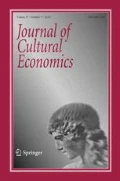Abstract
We measure the regional impact of the European Capital of Culture programme using a difference-in-differences approach. We compare the regions of cities that hosted the event with the regions of cities that tried to host it but did not succeed. GDP per capita in hosting regions is 4.5 % higher compared to non-hosting regions during the event, and the effect persists more than 5 years after it. This result suggests that the economic dimension of the event is important and supports claims that the event serves as catalyst for urban regeneration and development.

Similar content being viewed by others
Notes
Acording to Steiner et al. (2015), the budgets ranged from 5.5 million euros in Reykjavik to 59 million euros in Lille.
These are one or two cities per event that we could identify as being close runners-up. These are in bold in Table 3. In some cases, one or two cities went on to the preselection phase in the later years, when a two-phase selection process was stablished. In other cases, there was only one or two cities competing with the winner.
References
Boyko, C. T. (2007). Are you being served? The impacts of a tourist hallmark event on the place meanings of residents. Event Management, 11(4), 161–177.
Council of European Union (1985). Resolution of the ministers responsible for cultural affairs, meeting within the council, of 13 June 1985 concerning the annual event ‘European City of Culture’. 85/C 153/02.
Council of European Union (1990). Conclusions of the ministers of culture meeting within the council of 18 May 1990 on future eligibility for the ‘European City of Culture’ and on a special European Cultural Month event. 85/C 153/02.
European Capitals of Culture Policy Group. (2010). An international framework of good practice in research and delivery of the European Capital of Culture programme. Liverpool: University of Liverpool.
European Parliament and Council (1999). Decision 1419/1999/EC of the European Parliament and of the Council of 25 May 1999. European Council. http://eur-lex.europa.eu/LexUriServ/LexUriServ.do?uri=CONSLEG:1999D1419:20040501:EN:PDF.
European Parliament and Council (2006). Decision No. 1622/2006/EC of the European Parliament and of the Council of 24 October 2006. European Council. http://eur-lex.europa.eu/LexUriServ/LexUriServ.do?uri=OJ:L:2006:304:0001:0006:EN:PDF.
Garcia, B. (2005). Deconstructing the city of culture: The long-term cultural legacies of Glasgow 1990. Urban Studies, 42(5–6), 841–868.
Garcia, B. (2006). Media impact assessment (part I). Baseline findings on Liverpool press coverage before the European Capital of Culture (1996–2005). Impacts 08, Liverpool.
Garcia B. (2010). Media impact assessment (part II). Evolving press and broadcast narratives on Liverpool from 1996 to 2009. Impacts 08, Liverpool.
García, B., & Cox, T. (2013). European capitals of culture: Success strategies and long-term effects. Directorate general for internal policies, policy department B: Structural and cohesion policies. http://www.europarl.europa.eu/RegData/etudes/etudes/join/2013/513985/IPOLCULT_ET%282013%29513985_EN.pdf.
Greenstone, M., Hornbeck, R., & Moretti, E. (2010). Identifying agglomeration spillovers: Evidence from winners and losers of large plant openings. Journal of Political Economy, 118(3), 536–598.
Herrero, L. C., Sanz, J. Á., Devesa, M., Bedate, A., & Del Barrio, M. J. (2006). The economic impact of cultural events a case-study of salamanca 2002, European Capital of Culture. European Urban and Regional Studies, 13(1), 41–57.
Hong, S. H. (2011). Measuring the effect of napster on recorded music sales: Difference-in-differences estimates under compositional changes. Journal of Applied Econometrics, 28(2), 297–324.
Hughes, H., Allen, D., & Wasik, D. (2003). The significance of European “Capital of Culture” for tourism and culture: The case of Kraków 2000. International Journal of Arts Management, 5(3), 12–23.
Langen, F., & Garcia, B. (2009). Measuring the impacts of large scale cultural events: A literature review. Impacts 08: The Liverpool Model, European Capital of Culture Research Programme.
Mehrotra, A. (2012). To host or not to host? A comparison study on the long-run impact of the olympic games. Michigan Journal of Business, 5(2), 61–92.
Mora, R., & Reggio, E. (2013) Treatment effect identification using alternative parallel assumptions, Universidad Carlos III de Madrid working paper.
Myerscough, J. (1994). European cities of culture and cultural months: Summary report. Network of Cultural Cities of Europe.
Palmer, R. (2004). European capitals/cities of culture. Study on the European cities and capitals of culture and the European cultural months (1995–2004). Palmer/Rae Associates, European Commission, Brussels.
Richards, G., Hitters, E., & Fernandes, C. (2002). Rotterdam and Porto: Cultural capitals 2001: Visitor research. Arnhem: Atlas.
Rose, A., & Spiegel, M. (2011). The olympic effect. Economic Journal, 121(553), 652–677.
Steiner, L., Frei, B., & Hotz, S. (2015). European capitals of culture and life satisfaction. Urban Studies, 52(2), 374–394.
Author information
Authors and Affiliations
Corresponding author
Additional information
We would like to give particular thanks to Nuria Lombana, Sylvain Pasqua, Jeanne Alart, Rodolfo Maslias, Samuel Bentolila, Patricia Melo, Jan Stuhler, Iliana Reggio, seminar participants at the Universidad Carlos III and an anonymous referee.
Rights and permissions
About this article
Cite this article
Gomes, P., Librero-Cano, A. Evaluating three decades of the European Capital of Culture programme: a difference-in-differences approach. J Cult Econ 42, 57–73 (2018). https://doi.org/10.1007/s10824-016-9281-x
Received:
Accepted:
Published:
Issue Date:
DOI: https://doi.org/10.1007/s10824-016-9281-x




